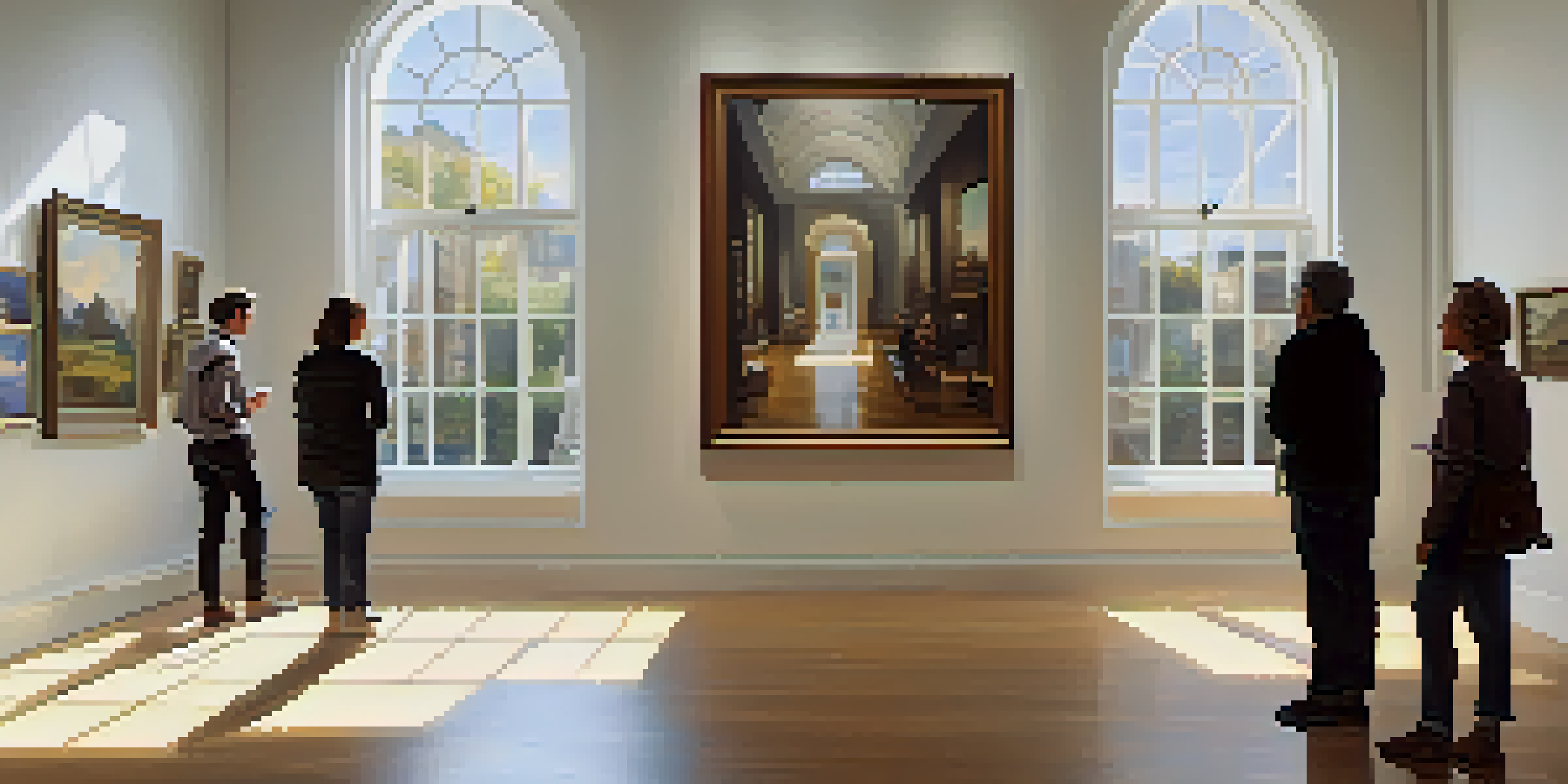Art Criticism and the Role of Audience Reception in Evaluation

Understanding Art Criticism: Definitions and Importance
Art criticism is the practice of analyzing and interpreting artworks, aiming to provide insights into their meaning and value. It plays a crucial role in the art world, helping both artists and audiences engage with art on a deeper level. By evaluating technique, theme, and context, critics can guide viewers through the often-complex landscape of artistic expression.
Art is not freedom from discipline, but disciplined freedom.
The importance of art criticism extends beyond mere evaluation; it fosters dialogue between the artist and the audience. This interaction can elevate the appreciation of art, as critics often highlight elements that viewers may overlook. Ultimately, criticism serves as a bridge, connecting diverse perspectives and enriching the art experience.
Moreover, art criticism can influence public perception and the market value of artworks. A positive review can propel an artist into the spotlight, while a negative critique might challenge the reception of their work. This dynamic underscores the power of criticism in shaping the narrative around art and artists.
The Role of Audience Reception in Art Evaluation
Audience reception refers to how viewers interpret and respond to art, which is a vital aspect of its evaluation. Unlike critics, audiences bring personal experiences and emotions to their interpretations, making their reception unique and varied. This diversity can lead to rich discussions and new insights about a work that may not align with critical analysis.

The relationship between audience reception and art criticism is often symbiotic. While critics provide context and guidance, audience reactions can challenge or affirm critical interpretations. This interplay can inspire critics to reconsider their evaluations and encourage artists to explore themes that resonate with viewers.
Art Criticism Fosters Dialogue
Art criticism serves as a bridge between artists and audiences, enriching the art experience through varied perspectives.
Additionally, audience reception can shift over time, influenced by cultural trends, societal changes, and personal growth. What might have been considered avant-garde at one moment could become mainstream years later, illustrating how public perception evolves. This fluidity highlights the importance of considering audience responses in the ongoing conversation about art.
Historical Context: Art Criticism Through the Ages
The history of art criticism dates back centuries, evolving alongside the art movements it seeks to evaluate. From the Renaissance to modern art, critics have shaped how we perceive and appreciate various styles and techniques. Understanding this historical context enriches our appreciation of art criticism itself, as we recognize its role in cultural dialogue.
Every artist dips his brush in his own soul, and paints his own nature into his pictures.
In earlier periods, critics often held significant influence, acting as gatekeepers to the art world. Their opinions could elevate an artist's status or diminish it entirely, showcasing the power dynamics at play. As art movements progressed, the democratization of criticism emerged, allowing more voices to contribute to the conversation.
Today, with the rise of social media and digital platforms, anyone can engage in art criticism. This shift has expanded the landscape, enabling a broader range of perspectives and experiences to shape art evaluation. The interplay between traditional criticism and audience feedback has never been more dynamic.
The Impact of Cultural Context on Art Interpretation
Cultural context plays a significant role in how art is interpreted and received. Different cultures bring unique perspectives, values, and histories that influence the way art is created and appreciated. This diversity enriches the art world, fostering a global dialogue that transcends geographical boundaries.
When audiences engage with art, their cultural backgrounds inform their interpretations. For example, a piece that resonates deeply with one culture might be misunderstood or overlooked by another. This highlights the importance of understanding cultural nuances when evaluating and critiquing art.
Cultural Context Shapes Interpretation
Different cultural backgrounds influence how art is created and perceived, highlighting the importance of diverse perspectives.
Furthermore, the globalized nature of today's art world means that cross-cultural exchanges are more prevalent than ever. Artists and critics can draw inspiration from a multitude of influences, creating a tapestry of perspectives that challenges traditional evaluations. This interconnectedness encourages audiences to embrace a more inclusive understanding of art.
The Influence of Technology on Art Criticism and Reception
Technology has dramatically transformed the landscape of art criticism and audience reception. With the rise of digital platforms, critics can share their insights with a global audience in real time. This accessibility has democratized art criticism, allowing diverse voices to emerge and shaping how art is experienced and evaluated.
Social media platforms, in particular, enable immediate feedback from audiences, creating a dialogue that was previously less accessible. Artists can gauge audience reactions almost instantaneously, adapting their work based on real-time input. This immediate interaction fosters a collaborative environment that can lead to innovative artistic expressions.
Additionally, technology has changed the way art is consumed. Virtual galleries and online exhibitions allow audiences to experience art from the comfort of their homes, broadening access. This shift not only alters how art is critiqued but also shapes audience reception, as viewers engage with works in ways that were not possible before.
Challenges in Art Criticism: Subjectivity and Bias
While art criticism aims to provide objective evaluations, subjectivity and bias can often creep in. Each critic brings their personal preferences, experiences, and cultural backgrounds into their analyses, which can color their interpretations. This subjectivity can lead to varied opinions on the same piece of art, highlighting the complexity of evaluation.
Bias can also manifest in art criticism based on trends, popular culture, or even the critic's own status in the art world. For instance, a well-established critic might receive more attention than an emerging voice, regardless of the quality of the work being critiqued. This dynamic can skew audience perceptions and influence which artworks gain recognition.
Technology Redefines Art Engagement
Advancements in technology have democratized art criticism and audience reception, creating new ways for people to experience and evaluate art.
To navigate these challenges, it’s essential for critics to acknowledge their biases and strive for transparency in their evaluations. Engaging with a diverse range of perspectives can also help broaden the conversation and create a more inclusive environment for art criticism. By embracing this complexity, we can foster a richer understanding of art.
Future Trends in Art Criticism and Audience Engagement
As we look to the future, art criticism and audience engagement are likely to evolve in exciting ways. With advancements in technology, virtual reality and augmented reality may play a significant role in how audiences experience art. These innovations could offer immersive experiences, transforming the relationship between art, criticism, and audience reception.
Moreover, the rise of participatory art practices invites audiences to take an active role in the creation and evaluation of art. This shift encourages collaboration and blurs the lines between artist and audience, fostering a more dynamic art community. Critics will need to adapt to these changes, considering audience input as a vital component of their evaluations.

Additionally, as the global art landscape continues to diversify, the demand for inclusive and representative criticism will grow. Critics will need to engage with a wider range of voices and perspectives, ensuring that all narratives are heard and valued. This future promises a richer, more interconnected art world that celebrates the interplay between art, criticism, and audience reception.